Implementation of work rotation in a metallurgical plant for electronic products.
DOI:
https://doi.org/10.15675/gepros.v0i3.169Abstract
Steel mill industries present problems related to movement repetitions and work complexity. These tasks also demand hand dexterity, promote work related to musculoskeletal disorders and cause worker´s low performance. The aim of this study was to implant the Workstation Rotation with an Ergonomic Approach (WREA) for mounters from the sector of a steel mill of electronic products. The initial process for implanting the WREA was defined considering seven priorities: identification of worker´s abilities; qualification program; ranking to work station; intercalation to double operations; qualification to new workers; accomplishment to qualification; the WREA beginning. It was verified some biomechanical factors in xx most of the mounters´ activities. Most syntoms were present on the shoulder, neck and back. With this methodology, it was possible to establish the WREA based on the priorities, in order to allow less exposition to risk, thus, to musculoskeletal disorders. The WREA methodology, used with Ergonomic Work Analysis, demonstrated to be a cientifical and simple instrument. Keywords: Erognomic Analysis; Rotation of Activities; MountersDownloads
Published
How to Cite
Issue
Section
License
O(s) autor(es) do artigo autorizam a publicação do texto na revista e garantem que a contribuição é original e inédita, não estando em processo de avaliação em outra(s) revista(s). As opiniões, ideias e conceitos emitidos nos textos são de inteira responsabilidade do(s) autor(es), não sendo a revista responsável por tais conteúdos.
Os editores da revista reservam o direito de efetuar ajustes textuais e de adequação às normas da publicação, caso necessário.
Os autores mantêm os direitos autorais sobre o trabalho e concedem à revista o direito de primeira publicação, sendo o trabalho simultaneamente licenciado sob a Attribution 4.0 International (CC BY 4.0), o que permite o compartilhamento do trabalho com reconhecimento da autoria e publicação inicial nesta revista.
Os autores têm autorização para firmar contratos adicionais, separadamente, para distribuição não-exclusiva da versão do trabalho publicada nesta revista (ex.: publicar em repositório institucional ou como capítulo de livro), com reconhecimento de autoria e publicação inicial nesta revista.














